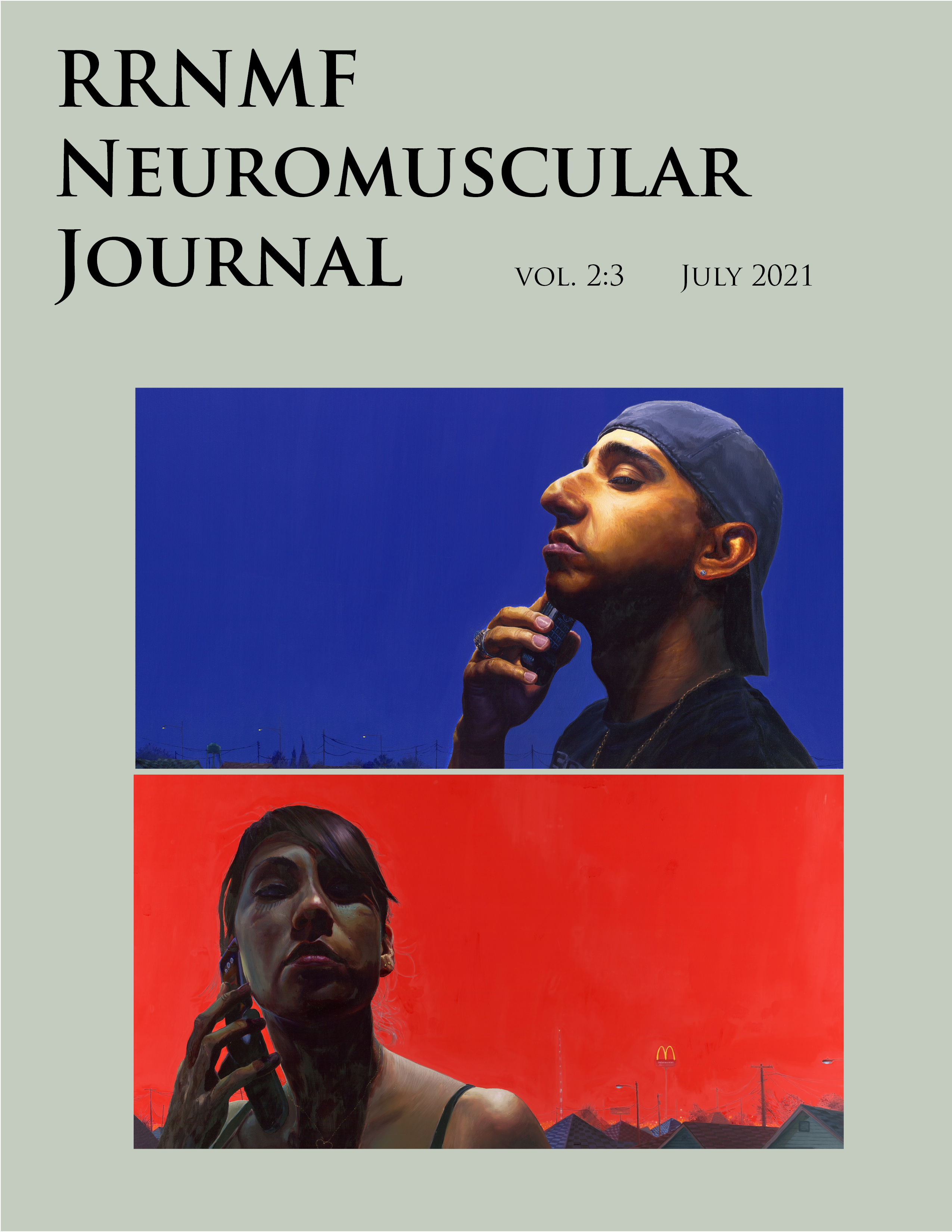Efficacy of botulinum toxin for treating cramps in peripheral neuropathy
DOI:
https://doi.org/10.17161/rrnmf.v2i3.14951Keywords:
cramps, peripheral neuropathy, botulinum toxin, lower limb, efficacyAbstract
Abstract
Introduction:
Muscle cramps are a common occurrence in patients with peripheral neuropathy and are known to cause significant distress and decrease the quality of life. Although several drug formulations have been used in the management of cramps, there is significant variability in terms of efficacy and tolerability in patients with peripheral neuropathy. This study aims to assess the efficacy of botulinum toxin A in the management of lower limb cramps in patients with peripheral neuropathy.
Methods:
This retrospective chart review included a total of ten patients with peripheral neuropathy with cramps. Relevant data such as age, gender, race, pain score and cause of peripheral neuropathy were documented. Statistical analyses to compare the variables was done using the Wilcoxon Test. The pain score before the administration, at 3-month, 6 month and 9 months follow up were compared.
Results
All patients enrolled in the study showed improvement of pain assessed by visual pain analog scale. An improvement of 1.60 (95%CI, p<0.05), 2.70 (95%CI, p<0.05) and 3.50 (95%CI, p=0.05) was noted between test scores from before administration of botulinum toxin to 3-month, 6 months and 9 months follow up with a range of 6, 4 and 4 respectively.
Conclusion:
Local BTX-A infiltration is a likely efficacious and safe procedure for improving pain associated with cramps in patients with peripheral neuropathy.
Downloads
References
Layzer RB. Muscle pain, cramps, and fatigue. In: Engel AG, Franzini-Armstrong C, eds. Myology. New York: McGraw-Hill 1994:3462-3497
Layzer RB. The origin of muscle fasciculations and cramps. Muscle Nerve 1994; 17:1243-1249
Abdulla AJ, Jones PW, Pearce VR. Leg cramps in the elderly: prevalence, drug and disease associations. Int J Clin Pract 1999;53: 494–6.
Naylor JR, Young JB. A general population survey of rest cramps. Age Ageing 1994; 23:418–20.
Hawke F, Chuter V, Burns J. Impact of nocturnal calf cramping on quality of sleep and health-related quality of life. Qual Life Res. 2013 Aug;22(6):1281-6. doi: 10.1007/s11136-012-0274-8. Epub 2012 Sep 26.
Blyton F, Chuter V, Burns J. Unknotting night-time muscle cramp: a survey of patient experience, help-seeking behaviour and perceived treatment effectiveness. J Foot Ankle Res 2012; 5:7.
Sidorov J. Quinine sulfate for leg cramps: does it work? J Am Geriatr Soc 1993; 41:498–500.
Garrison SR, Allan GM, Sekhon RK, et al. Magnesium for skeletal muscle cramps. Cochrane Database Syst Rev 2012;(9):CD009402.
Bialer M. Why are antiepileptic drugs used for nonepileptic condi- tions? Epilepsia 2012;53(suppl 7):26–33.
Cornelius VR, Sauzet O, Williams JE, et al. Adverse event reporting in randomised controlled trials of neuropathic pain: considerations for future practice. Pain 2013; 154:213–220.
Baldissera F, Cavallari P, Dworzak F. Motor neuron ’bistability’. A pathogenetic mechanism for cramps and myokymia. Brain 1994;117(Pt 5):929–39. [PUBMED:7953602]
Norris FH, Gasteiger EL, Chatfield PO. An electromyographic study of induced and spontaneous muscle cramps. Electroencephalography and Clinical Neurophysiology 1957;9(1):139–47. [PUBMED: 13404940]
Ross BH, Thomas CK. Human motor unit activity during induced muscle cramp. Brain 1995;118 (Pt 4):983–93. [PUBMED:7655893]
Simpson LL. The origin, structure and pharmacological activity of botulinum toxin. Pharmacol Rev 1981; 33:155-188
Pavone F, Luvisetto S. Botulinum neurotoxin for pain management: insights from animal models. Toxins (Basel) 2010; 2:2890–2913.
Bertolasi L, Priori A, Tomelleri G, et al. Botulinum toxin treatment of muscle cramps: a clinical and neurophysiological study. Ann Neurol 1997; 41:181–186
Restivo DA, Casabona A, Frittitta L et al. Efficacy of Botulinum Toxin A for Treating Cramps in Diabetic Neuropathy. Ann Neurol. 2018 Nov;84(5):674-682. doi: 10.1002/ana.25340. Epub 2018 Oct 16.
Katzberg H, Kokokyi S, Halpern E, et al. Prevalence of muscle cramps in patients with diabetes. Diabetes Care 2014;37: e17–e18.
Vangsted A, Klausen TW, Vogel U. Genetic variations in multiple myeloma II: association with effect of treatment. Eur J Haematol. 2012;88(2):93–117.
Costa J, Graca P, Evangelista T, de Carvalho M. Pain and calf hypertrophy associated with spontaneous repetitive discharges treated with botulinum toxin. Clin Neurophysiol. 2005 Dec;116(12):2847-52. Epub 2005 Oct 25.
Park SJ, Yoon KB, Yoon DM, Kim SH. Botulinum toxin treatment for nocturnal calf cramps in patients with lumbar spinal stenosis: a randomized clinical trial. Arch Phys Med Rehabil. 2017 May;98(5):957-963. doi: 10.1016/j.apmr.2017.01.017. Epub 2017 Feb 14.
Downloads
Published
Issue
Section
License
Copyright (c) 2021 Tejas Mehta, Richard Sommers, Raghav Govindarajan

This work is licensed under a Creative Commons Attribution-NonCommercial-NoDerivatives 4.0 International License.

